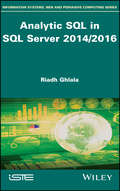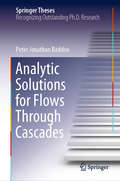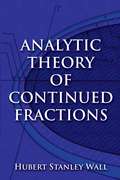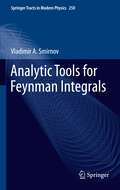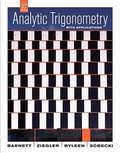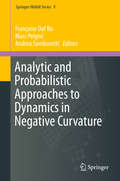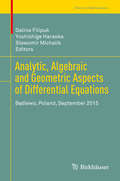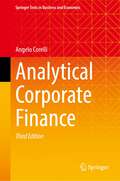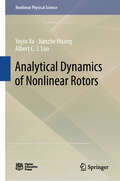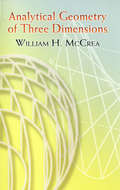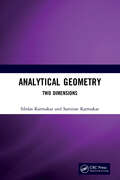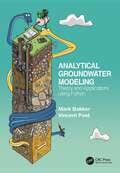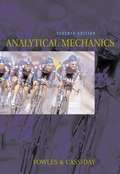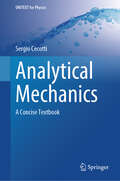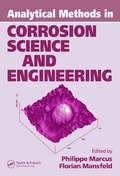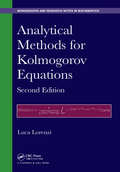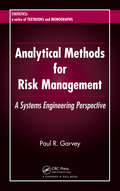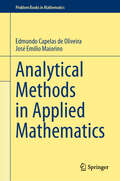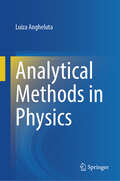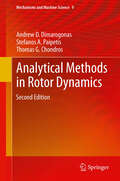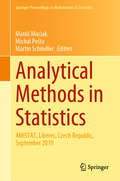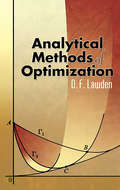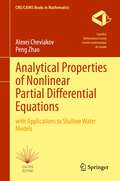- Table View
- List View
Analytic Pattern Matching
by Philippe Jacquet Wojciech SzpankowskiHow do you distinguish a cat from a dog by their DNA? Did Shakespeare really write all of his plays? Pattern matching techniques can offer answers to these questions and to many others, from molecular biology, to telecommunications, to classifying Twitter content. This book for researchers and graduate students demonstrates the probabilistic approach to pattern matching, which predicts the performance of pattern matching algorithms with very high precision using analytic combinatorics and analytic information theory. Part I compiles known results of pattern matching problems via analytic methods. Part II focuses on applications to various data structures on words, such as digital trees, suffix trees, string complexity and string-based data compression. The authors use results and techniques from Part I and also introduce new methodology such as the Mellin transform and analytic depoissonization. More than 100 end-of-chapter problems help the reader to make the link between theory and practice.
Analytic SQL in SQL Server 2014/2016
by Riadh GhlalaBusiness Intelligence (BI) has emerged as a field which seeks to support managers in decision-making. It encompasses the techniques, methods and tools for conducting analytically-based IT solutions, which are referred to as OLAP (OnLine Analytical Processing). Within this field, SQL has a role as a leader and is continuously evolving to cover both transactional and analytical data management. This book discusses the functions provided by Microsoft® SQL Server 2014/2016 in terms of business intelligence. The analytic functions are considered as an enrichment of the SQL language. They combine a series of practical functions to answer complex analysis requests with all the simplicity, elegance and acquired performance of the SQL language. Drawing on the wide experience of the author in teaching and research, as well as insights from contacts in the industry, this book focuses on the issues and difficulties faced by academics (students and teachers) and professionals engaged in data analysis with the SQL Server 2014/2016 database management system.
Analytic Semigroups and Semilinear Initial Boundary Value Problems
by Kazuaki TairaThis book provides a careful and accessible exposition of the function analytic approach to initial boundary value problems for semilinear parabolic differential equations. It focuses on the relationship between two interrelated subjects in analysis: analytic semigroups and initial boundary value problems. This semigroup approach can be traced back to the pioneering work of Fujita and Kato on the Navier-Stokes equation. The author studies non homogeneous boundary value problems for second order elliptic differential operators, in the framework of Sobolev spaces of Lp style, which include as particular cases the Dirichlet and Neumann problems, and proves that these boundary value problems provide an example of analytic semigroups in Lp. This book will be a necessary purchase for researchers with an interest in analytic semigroups or initial value problems.
Analytic Solutions for Flows Through Cascades (Springer Theses)
by Peter Jonathan BaddooThis thesis is concerned with flows through cascades, i.e. periodic arrays of obstacles. Such geometries are relevant to a range of physical scenarios, chiefly the aerodynamics and aeroacoustics of turbomachinery flows. Despite the fact that turbomachinery is of paramount importance to a number of industries, many of the underlying mechanisms in cascade flows remain opaque. In order to clarify the function of different physical parameters, the author considers six separate problems. For example, he explores the significance of realistic blade geometries in predicting turbomachinery performance, and the possibility that porous blades can achieve noise reductions. In order to solve these challenging problems, the author deploys and indeed develops techniques from across the spectrum of complex analysis: the Wiener–Hopf method, Riemann–Hilbert problems, and the Schottky–Klein prime function all feature prominently. These sophisticated tools are then used to elucidate the underlying mathematical and physical structures present in cascade flows. The ensuing solutions greatly extend previous works and offer new avenues for future research. The results are not of simply academic value but are also useful for aircraft designers seeking to balance aeroacoustic and aerodynamic effects.
Analytic Theory of Continued Fractions (Dover Books on Mathematics)
by Hubert Stanley WallOne of the most authoritative and comprehensive books on the subject of continued fractions, this monograph has been widely used by generations of mathematicians and their students. Dr. Hubert Stanley Wall presents a unified theory correlating certain parts and applications of the subject within a larger analytic structure. Prerequisites include a first course in function theory and knowledge of the elementary properties of linear transformations in the complex plane. Some background in number theory, real analysis, and complex analysis may also prove helpful. The two-part treatment begins with an exploration of convergence theory, addressing continued fractions as products of linear fractional transformations, convergence theorems, and the theory of positive definite continued fractions, as well as other topics. The second part, focusing on function theory, covers the theory of equations, matrix theory of continued fractions, bounded analytic functions, and many additional subjects.
Analytic Tools for Feynman Integrals (Springer Tracts in Modern Physics #250)
by Vladimir A. SmirnovThe goal of this book is to describe the most powerful methods for evaluating multiloop Feynman integrals that are currently used in practice. This book supersedes the author's previous Springer book "Evaluating Feynman Integrals" and its textbook version "Feynman Integral Calculus." Since the publication of these two books, powerful new methods have arisen and conventional methods have been improved on in essential ways. A further qualitative change is the fact that most of the methods and the corresponding algorithms have now been implemented in computer codes which are often public. In comparison to the two previous books, three new chapters have been added: One is on sector decomposition, while the second describes a new method by Lee. The third new chapter concerns the asymptotic expansions of Feynman integrals in momenta and masses, which were described in detail in another Springer book, "Applied Asymptotic Expansions in Momenta and Masses," by the author. This chapter describes, on the basis of papers that appeared after the publication of said book, how to algorithmically discover the regions relevant to a given limit within the strategy of expansion by regions. In addition, the chapters on the method of Mellin-Barnes representation and on the method of integration by parts have been substantially rewritten, with an emphasis on the corresponding algorithms and computer codes.
Analytic Trigonometry with Applications (10th Edition)
by Raymond A. Barnett Michael R. Ziegler Karl E. Byleen Dave SobeckiThe 10th edition of Analytic Trigonometry with Applications is designed for a one-term course in trigonometry and for students who have had 1 1/2-2 years of high school algebra or the equivalent.
Analytic and Probabilistic Approaches to Dynamics in Negative Curvature (Springer INdAM Series #9)
by Françoise Dal'Bo Marc Peigné Andrea SambusettiThe work consists of two introductory courses, developing different points of view on the study of the asymptotic behaviour of the geodesic flow, namely: the probabilistic approach via martingales and mixing (by Stéphane Le Borgne); the semi-classical approach, by operator theory and resonances (by Frédéric Faure and Masato Tsujii). The contributions aim to give a self-contained introduction to the ideas behind the three different approaches to the investigation of hyperbolic dynamics. The first contribution focus on the convergence towards a Gaussian law of suitably normalized ergodic sums (Central Limit Theorem). The second one deals with Transfer Operators and the structure of their spectrum (Ruelle-Pollicott resonances), explaining the relation with the asymptotics of time correlation function and the periodic orbits of the dynamics.
Analytic, Algebraic and Geometric Aspects of Differential Equations: Będlewo, Poland, September 2015 (Trends in Mathematics)
by Galina Filipuk Yoshishige Haraoka Sławomir MichalikThis volume consists of invited lecture notes, survey papers and original research papers from the AAGADE school and conference held in Będlewo, Poland in September 2015. The contributions provide an overview of the current level of interaction between algebra, geometry and analysis and demonstrate the manifold aspects of the theory of ordinary and partial differential equations, while also pointing out the highly fruitful interrelations between those aspects. These interactions continue to yield new developments, not only in the theory of differential equations but also in several related areas of mathematics and physics such as differential geometry, representation theory, number theory and mathematical physics. The main goal of the volume is to introduce basic concepts, techniques, detailed and illustrative examples and theorems (in a manner suitable for non-specialists), and to present recent developments in the field, together with open problems for more advanced and experienced readers. It will be of interest to graduate students, early-career researchers and specialists in analysis, geometry, algebra and related areas, as well as anyone interested in learning new methods and techniques.
Analytical Corporate Finance (Springer Texts in Business and Economics)
by Angelo CorelliThis book draws readers’ attention to the financial aspects of daily life at a corporation by combining a robust mathematical setting and the explanation and derivation of the most popular models of the firm. Intended for third-year undergraduate students of business finance, quantitative finance, and financial mathematics, as well as first-year postgraduate students, it is based on the twin pillars of theory and analytics, which merge in a way that makes it easy for students to understand the exact meaning of the concepts and their representation and applicability in real-world contexts. Examples are given throughout the chapters in order to clarify the most intricate aspects; where needed, there are appendices at the end of chapters, offering additional mathematical insights into specific topics. Due to the recent growth in knowledge demand in the private sector, practitioners can also profit from the book as a bridge-builder between university and industry. Lastly, the book provides useful information for managers who want to deepen their understanding of risk management and come to recognize what may have been lacking in their own systems.
Analytical Dynamics of Nonlinear Rotors (Nonlinear Physical Science)
by Albert C. Luo Yeyin Xu Jianzhe HuangThis book is a monograph about the analytical dynamics of nonlinear rotor systems. The analytical solutions of periodic motions in nonlinear rotor systems are presented in this book. To help one understand the analytical solutions, the generalized harmonic balance method for periodic motions in polynomial nonlinear systems is briefly reviewed first, and then the semi-analytical method for periodic motions in any nonlinear systems is presented briefly too, which is also called the implicit mapping method. Such two analytical methods are employed to determine the solutions of periodic motions in nonlinear rotor systems. The analytical expressions of periodic motions to chaos for nonlinear rotor systems are presented, and the frequency-amplitude characteristics of nonlinear rotor systems are discussed. In addition, the accurate modeling of nonlinear rotors with oil films is presented, and the periodic motions of such fully nonlinear oil-film rotor systems are developed through the semi-analytical method. This book provides a better understanding of frequency-amplitude characteristics in nonlinear rotor systems. The methodology presented in this book can help one study complicated nonlinear rotor systems.
Analytical Geometry of Three Dimensions: Second Revised Version
by William H. McCreaBrief but rigorous, this text is geared toward advanced undergraduates and graduate students. It covers the coordinate system, planes and lines, spheres, homogeneous coordinates, general equations of the second degree, quadric in Cartesian coordinates, and intersection of quadrics.Mathematician, physicist, and astronomer, William H. McCrea conducted research in many areas and is best known for his work on relativity and cosmology. McCrea studied and taught at universities around the world, and this book is based on a series of his lectures.
Analytical Geometry: Two Dimensions
by Sibdas Karmakar Samiran KarmakarThis book is a compilation of all basic topics of Analytical Geometry of Two Dimensions and is intended to serve as an introductory text aimed towards undergraduate and graduate students in science and technology. An understanding of basic school level algebra and geometry can serve as the prerequisite for following this book. The present work is no original work but an attempt to make the subject thoroughly intelligible. All the important properties of the conics have been discussed either in the articles or in illustrative examples. Each chapter has sufficient completely solved problems and a set of carefully graded and motivating unsolved exercises. Please note: Taylor & Francis does not sell or distribute the Hardback in India, Pakistan, Nepal, Bhutan, Bangladesh and Sri Lanka.
Analytical Groundwater Modeling: Theory and Applications using Python
by Vincent Post Mark BakkerThis book provides a detailed description of how Python can be used to give insight into the flow of groundwater based on analytic solutions. Starting with simple problems to illustrate the basic principles, complexity is added step by step to show how one-dimensional and two-dimensional models of one or two aquifers can be implemented. Steady and transient flow problems are discussed in confined, semi-confined, and unconfined aquifers that may include wells, rivers, and areal recharge. Special consideration is given to coastal aquifers, including the effect of tides and the simulation of interface flow. Application of Python allows for compact and readable code, and quick visualization of the solutions. Python scripts are provided to reproduce all results. The scripts are also available online so that they can be altered to meet site-specific conditions. This book is intended both as training material for the next generation of university students and as a useful resource for practitioners. A primer is included for those who are new to Python or as a refresher for existing users.
Analytical Mechanics (Seventh Edition)
by Grant R. Fowles George L. CassidayThis textbook is intended for an undergraduate course in classical mechanics taken by students majoring in physics, physical science, or engineering.
Analytical Mechanics: A Concise Textbook (UNITEXT for Physics)
by Sergio CecottiThis textbook is based on the author's lecture notes held at Qiuzhen College, Tsinghua University, Beijing, renowned for its rapid scientific growth of its excellent students. The book offers a remarkable combination of characteristics that are both exceptional and seemingly contradictory. It is designed to be entirely self-contained, starting from the basics and building a strong foundation in geometric and algebraic tools. Simultaneously, topics are infused with mathematical elegance and profundity, employing contemporary language and techniques. From a physicist's perspective, the content delves deeply into the physical aspects, emphasizing the underlying principles. This book bridges the gap between students and cutting-edge research, with a special focus on symplectic geometry, integrability, and recent developments in the field. It is designed to engage and captivate the reader. A conscious selection of topics ensures a more relevant and contemporary approach compared to traditional textbooks. The book addresses common misconceptions, offering clarity and precision. In its quest for brevity, this book is tailored for a one-semester course, offering a comprehensive and concise resource. The author's dedication is evident throughout this volume, encapsulating these goals within roughly 300 pages.
Analytical Methods In Corrosion Science and Engineering (Corrosion Technology)
by Philippe Marcus Florian MansfeldDamage from corrosion costs billions of dollars per year. Controlling corrosion requires a fundamental, in-depth understanding of the mechanisms and phenomena involved, and this understanding is best achieved through advanced analytical methods. The first book to treat both surface analytical and electrochemical techniques in a single reference, An
Analytical Methods for Kolmogorov Equations (Chapman & Hall/CRC Monographs and Research Notes in Mathematics #25)
by Luca LorenziThe second edition of this book has a new title that more accurately reflects the table of contents. Over the past few years, many new results have been proven in the field of partial differential equations. This edition takes those new results into account, in particular the study of nonautonomous operators with unbounded coefficients, which has received great attention. Additionally, this edition is the first to use a unified approach to contain the new results in a singular place.
Analytical Methods for Risk Management: A Systems Engineering Perspective (Statistics: A Series of Textbooks and Monographs)
by Paul R. GarveyA Text on the Foundation Processes, Analytical Principles, and Implementation Practices of Engineering Risk ManagementDrawing from the author's many years of hands-on experience in the field, Analytical Methods for Risk Management: A Systems Engineering Perspectivepresents the foundation processes and analytical practices
Analytical Methods in Applied Mathematics (Problem Books in Mathematics)
by Edmundo Capelas de Oliveira José Emílio MaiorinoThis book compiles an extensive list of solved and proposed problems in mathematical topics in analysis, aimed at students of mathematics, applied mathematics, physics, and engineering. The book begins with an exploration of simple linear and nonlinear ordinary differential equations in Chapter 1, advancing through topics such as power series and the Frobenius method for solving differential equations in Chapter 2. In subsequent chapters, the discussion expands to include functions of complex variables, special functions constructed through the hypergeometric function, and series solutions including Fourier, Fourier-Bessel, and Fourier-Legendre series. Problems in integral transforms, Sturm-Liouville systems, Green's function, linear partial differential equations are also included. The work finishes with a special chapter on fractional calculus and practical applications of the topics presented. With solved examples and step-by-step exercises, this book can be of value to undergraduate and graduate students seeking a hands-on approach on the listed topics, and as a bibliographical complement to STEM courses as well.
Analytical Methods in Physics
by Luiza AnghelutaThis textbook is based on lectures for a third-year course on mathematical methods in physics taught in the Department of Physics at the University of Oslo. This textbook contains 26 lectures organized into five topics: i) Complex Analysis, ii) Variational Calculus, iii) Ordinary Differential Equations, iv) Integral Transformations, and v) Partial Differential Equations. For each topic, basic fundamental theorems and mathematical techniques are introduced and applied to solving problems. This resource is intended as concise and well-structured, making it suitable for a one-semester course. It is aimed at second- or third-year undergraduate students with background in mathematics and physical science.
Analytical Methods in Rotor Dynamics: Second Edition (Mechanisms and Machine Science #9)
by Thomas G. Chondros Stefanos A. Paipetis Andrew D. DimarogonasThe design and construction of rotating machinery operating at supercritical speeds was, in the 1920s, an event of revolutionary importance for the then new branch of dynamics known as rotor dynamics. In the 1960s, another revolution occurred: In less than a decade, imposed by operational and economic needs, an increase in the power of turbomachinery by one order of magnitude took place. Dynamic analysis of complex rotor forms became a necessity, while the importance of approximate methods for dynamic analysis was stressed. Finally, the emergence of fracture mechanics, as a new branch of applied mechanics, provided analytical tools to investigate crack influence on the dynamic behavior of rotors. The scope of this book is based on all these developments. No topics related to the well-known classical problems are included, rather the book deals exclusively with modern high-power turbomachinery.
Analytical Methods in Statistics: AMISTAT, Liberec, Czech Republic, September 2019 (Springer Proceedings in Mathematics & Statistics #329)
by Martin Schindler Matúš Maciak Michal PeštaThis book collects peer-reviewed contributions on modern statistical methods and topics, stemming from the third workshop on Analytical Methods in Statistics, AMISTAT 2019, held in Liberec, Czech Republic, on September 16-19, 2019. Real-life problems demand statistical solutions, which in turn require new and profound mathematical methods. As such, the book is not only a collection of solved problems but also a source of new methods and their practical extensions. The authoritative contributions focus on analytical methods in statistics, asymptotics, estimation and Fisher information, robustness, stochastic models and inequalities, and other related fields; further, they address e.g. average autoregression quantiles, neural networks, weighted empirical minimum distance estimators, implied volatility surface estimation, the Grenander estimator, non-Gaussian component analysis, meta learning, and high-dimensional errors-in-variables models.
Analytical Methods of Optimization (Dover Books on Mathematics)
by D. F. LawdenSuitable for advanced undergraduates and graduate students, this text surveys the classical theory of the calculus of variations. It takes the approach most appropriate for applications to problems of optimizing the behavior of engineering systems. Two of these problem areas have strongly influenced this presentation: the design of the control systems and the choice of rocket trajectories to be followed by terrestrial and extraterrestrial vehicles.Topics include static systems, control systems, additional constraints, the Hamilton-Jacobi equation, and the accessory optimization problem. Prerequisites include a course in the analysis of functions of many real variables and a familiarity with the elementary theory of ordinary differential equations, especially linear equations. Emphasis throughout the text is placed upon methods and principles, which are illustrated by worked problems and sets of exercises. Solutions to the exercises are available from the publisher upon request.
Analytical Properties of Nonlinear Partial Differential Equations: with Applications to Shallow Water Models (CMS/CAIMS Books in Mathematics #10)
by Alexei Cheviakov Shanghai Maritime UniversityNonlinear partial differential equations (PDE) are at the core of mathematical modeling. In the past decades and recent years, multiple analytical methods to study various aspects of the mathematical structure of nonlinear PDEs have been developed. Those aspects include C- and S-integrability, Lagrangian and Hamiltonian formulations, equivalence transformations, local and nonlocal symmetries, conservation laws, and more. Modern computational approaches and symbolic software can be employed to systematically derive and use such properties, and where possible, construct exact and approximate solutions of nonlinear equations. This book contains a consistent overview of multiple properties of nonlinear PDEs, their relations, computation algorithms, and a uniformly presented set of examples of application of these methods to specific PDEs. Examples include both well known nonlinear PDEs and less famous systems that arise in the context of shallow water waves and far beyond. The book will beof interest to researchers and graduate students in applied mathematics, physics, and engineering, and can be used as a basis for research, study, reference, and applications.

